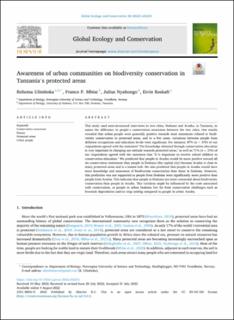| dc.contributor.author | Mwasaga, Rehema Ulimboka | |
| dc.contributor.author | Mbise, Franco Peniel | |
| dc.contributor.author | Nyahongo, Julius William | |
| dc.contributor.author | Røskaft, Eivin | |
| dc.date.accessioned | 2023-02-23T08:48:06Z | |
| dc.date.available | 2023-02-23T08:48:06Z | |
| dc.date.created | 2022-08-24T16:33:13Z | |
| dc.date.issued | 2022 | |
| dc.identifier.citation | Global Ecology and Conservation. 2022, 38 . | en_US |
| dc.identifier.issn | 2351-9894 | |
| dc.identifier.uri | https://hdl.handle.net/11250/3053482 | |
| dc.description.abstract | This study used semi-structured interviews in two cities, Dodoma and Arusha, in Tanzania, to assess the difference in people’s conservation awareness between the two cities. Our results revealed that urban people were generally positive towards most statements related to biodiversity conservation in protected areas, and in a few cases, variations between people from different occupations and education levels were significant. For instance, 87% (n = 376) of our respondents agreed with the statement "The knowledge obtained through conservation education is very important in changing our attitude towards protected areas," as well as 71% (n = 376) of our respondents agreed with the statement that "It is important to involve school children in conservation education." We predicted that people in Arusha would be more positive toward all six conservation statements than people in Dodoma (the capital city) because Arusha is close to many protected areas and is a tourist hub. We also predicted that people in Arusha would have more knowledge and awareness of biodiversity conservation than those in Dodoma. However, this prediction was not supported as people from Dodoma were significantly more positive than people from Arusha. This indicates that people in Dodoma are more concerned about biodiversity conservation than people in Arusha. This variation might be influenced by the costs associated with conservation, as people in urban Dodoma live far from conservation challenges such as livestock depredation and/or crop raiding compared to people in urban Arusha. | en_US |
| dc.language.iso | eng | en_US |
| dc.publisher | Elsevier Science | en_US |
| dc.rights | Attribution-NonCommercial-NoDerivatives 4.0 Internasjonal | * |
| dc.rights.uri | http://creativecommons.org/licenses/by-nc-nd/4.0/deed.no | * |
| dc.title | Awareness of urban communities on biodiversity conservation in Tanzania's protected areas | en_US |
| dc.title.alternative | Awareness of urban communities on biodiversity conservation in Tanzania's protected areas | en_US |
| dc.type | Peer reviewed | en_US |
| dc.type | Journal article | en_US |
| dc.description.version | publishedVersion | en_US |
| dc.source.volume | 38 | en_US |
| dc.source.journal | Global Ecology and Conservation | en_US |
| dc.identifier.doi | 10.1016/j.gecco.2022.e02251 | |
| dc.identifier.cristin | 2045773 | |
| dc.source.articlenumber | e02251 | en_US |
| cristin.ispublished | true | |
| cristin.fulltext | original | |
| cristin.qualitycode | 1 | |

